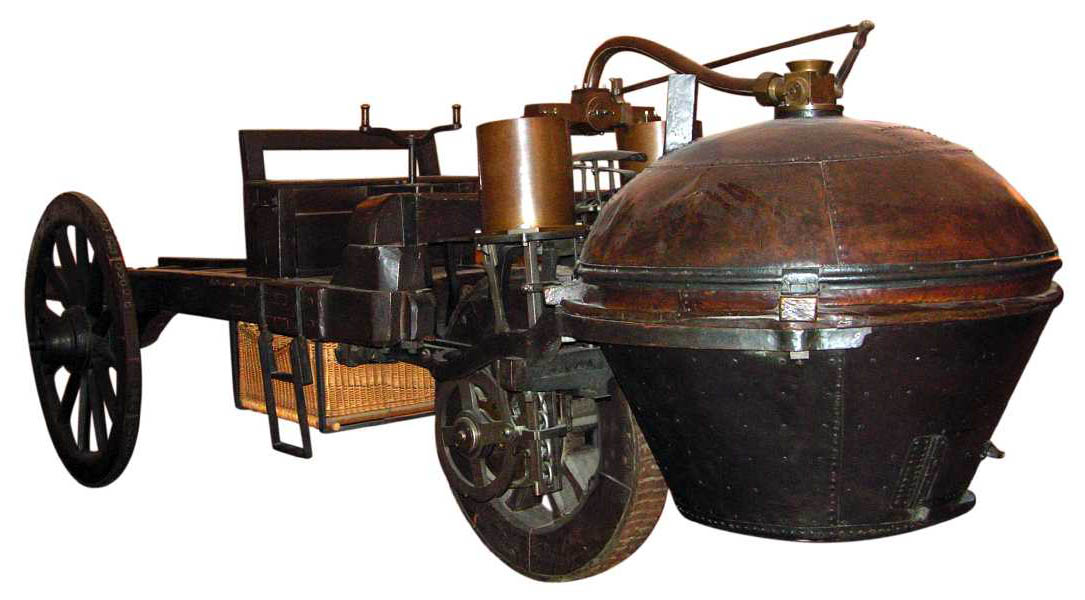The first carriages without horses.

Dreams about self-propelled machines have long occupied human minds. Already in the Middle Ages, there were vehicles driven by people hidden inside. In 1490. Leonardo da Vinci constructed a manually operated vehicle, and then, after 1769 r., when James Watt built the steam engine, the first steam road vehicles of the French Cugnot appeared (1769—1770), Trevithicka postal coach (1801), Hancock passenger steam vehicle (1822), French steam omnibus (1873). It was widely believed, that a suitable driving force for self-propelled vehicles was discovered in the pair.
At the same time, progress was made in another area as well. W 1806 r. in the Swiss canton of Wallis, a vehicle was built in the workshop of Isaac de Rivaz, which has traveled a distance of several meters, moving thanks to the power of the internal combustion engine. Soon, the Frenchman Lenoir had the idea to mix gasoline gases with air and used the mixture as a propellant. Its simple engine moved the vehicle, who traveled the route between Paris and Joinville-le-Pont.
After Lenoir's experiment, Nicolaus August Otto continued work on its engine, which had a small workshop in Cologne on the Rhine. It was during one of the trials that he came up with an idea that was decisive for the development of an internal combustion engine: compression of the fuel-air mixture in the combustion chamber and a four-stroke cycle. Otto patented in 1876. four-stroke work cycle, without knowing, that the French Beau de Rochas already in. 1862 explained theoretically the principle of operation of this type of engine. After the complaint was lodged by Rochas's heirs, the Reichs Court in January 1886 r. revoked Otta's patent, from now on, everyone who wanted and had the opportunity, could produce four-stroke engines.
Next in a long line of designers of today's car is Gottlieb Daimler, who set himself the goal of building a light gasoline engine, suitable for propelling vehicles. The result of Daimler's intense work was a high-speed single-cylinder engine. He had 700 revolutions per minute and capacity 460 cm3 developed power 1,1 kW (1,5 KM). It operated with incandescent ignition and an evaporative carburetor.
At the time Carl Benz built the village of 1885 r. in Mannheim his three-wheeled car, Daimler built the world's first motorcycle - on a wooden frame and wooden forged wheels. The motorcycle weighed 90 kg and reached speed 12 km/h. Daimler engines were fan cooled and placed in a frame on rubber spring elements. In the fall 1886 r. Daimler amazed its compatriots with the first 4-wheeled vehicle, equipped with a high-speed internal combustion engine, developing speed 18 km/h. After the world exhibition in Paris in 1889 r. Benz and Daimler's cars were gaining more and more popularity. In the following years, the engine power increased rapidly to 15, 20 and even 45 kW (20, 26, 60 KM). The belt transmission has disappeared and the concept of a motor vehicle has established itself: front engine, clutch, gearbox, Drive shaft, differential and rigid rear axle. The winner was a gearbox with four gears engaged by a yoke. Designers have already dealt with the importance of the relationship between the cylinder diameter and the stroke of the piston, cylinder filling problems and many other solutions important to the construction of engines of increasing power, and more economical at the same time. Bosch's magneto appeared at the turn of the century.
The brakes of ever faster cars were relatively weak and soon became the number one problem. To strengthen the handbrake, the vehicles had stable mountain supports, which were quickly drained, when the car was about to stop on a slope. W 1900 r. the provision was already in force, that each car must have two brakes that are independent of each other. Footbrake, made as jaw, acted on the rear or front cat. The handbrake has become an auxiliary brake.
Initially, there was no thought about electric car lighting, because a bright carbide lighting just appeared.
The first car competitions and races were another impulse for the development of automotive technology. In the race for the Gordon Bennett Cup in 1900 r. for the first time, permanent regulations for this type of event were developed. The cars couldn't be lighter than that 400 kg, and their maximum mass could not exceed 1000 kg.
Rallies for the Hercomer's Passing Award, organized from 1905 do 1907 r., only four-seater cars were allowed. The vehicles had to be equipped according to the car-tourism concepts of the time. For the first time, the starting cars were divided into classes according to engine power. It was similar during the next races for the Cup of Prince Henry of Prussia. The development of the racing regulations resulted in, that better construction materials began to be used. The innovative elements included ball bearings, mechanically operated valves, multi-stage gearboxes, improved carburetors and many other details, increasing engine power and driving speed. W 1906 r. races for the so-called. Grand Prize, which took place after the First World War until 1921 r. During this period, the design of more powerful engines depended on compressors. The power of the engines supercharged with the help of compressors allowed the racing cars to reach unbelievable speed.
Cars of various designs were produced in numerous car factories, the most interesting of which are described in detail later.